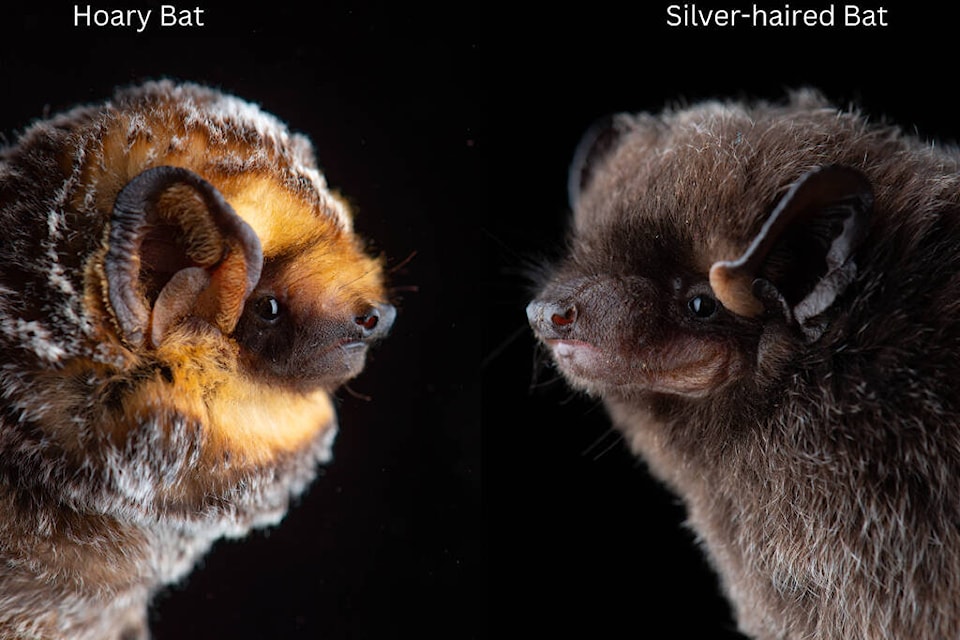Roseanne Van Ee
Okanagan’s Nature Nut
Despite the atypical warm temperatures this season, winter remains a challenging time for local wildlife. As temperatures drop, many animals struggle to find sustenance, leading them to either hibernate or migrate south for the season.
In the Okanagan, our resident insect-loving bats are facing a unique winter challenge. We only have insectivorous (insect-eating) bats in Canada – there are no blood-sucking or fruit-eating bats here. And since most insects disappear in the winter, bats too must take a break from feasting on moths and flies and instead wait out the cold season. So, what are their options for overwintering?
To brave the long, cold, and food-deficient winter months, bats fuel up on bugs and store energy in their fat like bears; enough to last them until spring. Some bats can store up to 50 per cent of their summer weight – quite astonishing! Imagine gaining and loosing that much of your body weight every year!
Of the 14 bat species commonly found in the Okanagan, two – Hoary bat and occasionally Silver-haired Bat – embrace migration. These tree-roosting bats head south in the fall, returning to B.C. in the spring. As the only true flying mammals, bats cover considerable distances of up to 2,000 kilometres. Their body shape varies from non-migratory bats with longer and narrower wings. They migrate for better food and shelter, seeking out leafy trees to hide in and stay warm. The added benefit? Bats transfer nutrients between their winter and summer grounds, in the form of guano (bat poop), enriching the Okanagan’s soil, crops, and gardens with a natural fertilizer.
The rest of the Okanagan bats overwinter locally, surviving on their fat reserves. Since bats are mammals, their normal body activity is similar to ours. However, during the winter, they enter a state of torpor - a winter slumber where their body processes slow down, reducing metabolism by lowering temperature, heart rate, and overall activity. Torpor allows bats to conserve energy and survive long winter months. Bats reduce their heartbeat by tenfold and slow their breathing to one breath per hour! Bats body temperature drops to just above freezing during torpor. They wake periodically to warm up by burning fat or moving to a warmer roost. They might also wake up to lick some melting snow or condensation inside the roost. One record had a bat flying in the south Okanagan in -14C!
Depending on the species, bats may overwinter in caves, rock crevices, abandoned mines, under the bark of mature trees and occasionally insulated attics (though uncommon in this area). They choose places that have optimal temperature to lower metabolism and high humidity to avoid dehydration. Bats often huddle together for warmth and to keep each other cozy.
Our bats remain largely understudied. The BC Community Bat Program provides an opportunity for enthusiasts to engage in citizen science, learn about local bats and raise awareness on different bats in our area. If you observe winter bat activity or encounter an injured or dead bat, report it to the North Okanagan Community Bat Program, at northokanaganbats@gmail.com or by calling 1-855-922-2287 (ext. 13). Alternatively, you can submit your findings at www.bcbats.ca. This program runs thanks to funding from the North Okanagan Conservation Fund, Habitat Conservation Trust Fund, and Habitat Stewardship Program and is administered by the BC Conservation Foundation.
In conclusion, spare a thought for our winged neighbors who have their unique way of spending winter. Get involved, be a bat advocate, and contribute to the well-being of these fascinating animals.
Roseanne Van Ee enthusiastically shares her knowledge of the outdoors to help readers experience and enjoy nature. Follow her on Facebook.
READ MORE: Okanagan’s Nature Nut: Freezing lakes
READ MORE: Bats in North Okanagan threatened by fungus
